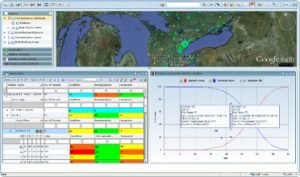Sacramento Municipal Utility District (SMUD) Visualizes Smart Grid with Space-Time Insight’s Situational Intelligence Software
Correlation and Analysis of Smart Meter, Distribution, Outage, and Environmental Data Leads to Faster, Smarter Decisions
 Space?Time Insight, the leading provider of next?generation situational intelligence solutions, today announced that the Sacramento Municipal Utility District (SMUD) has implemented Space-Time Insight’s geospatial and visual analytics software. The software facilitates faster and more informed smart grid decisions. The system, which correlates, analyzes and visualizes data in smart grid, distribution, outage, fire and weather systems, is the primary “face” of SMUD’s new Distribution Operations Center. The situational intelligence solution was implemented as part of SMUD’s Situational Awareness and Visual Intelligence (SAVI) initiative which is designed to improve the speed and quality of data analysis and decision-making throughout the organization’s Grid Planning and Operations department.
Space?Time Insight, the leading provider of next?generation situational intelligence solutions, today announced that the Sacramento Municipal Utility District (SMUD) has implemented Space-Time Insight’s geospatial and visual analytics software. The software facilitates faster and more informed smart grid decisions. The system, which correlates, analyzes and visualizes data in smart grid, distribution, outage, fire and weather systems, is the primary “face” of SMUD’s new Distribution Operations Center. The situational intelligence solution was implemented as part of SMUD’s Situational Awareness and Visual Intelligence (SAVI) initiative which is designed to improve the speed and quality of data analysis and decision-making throughout the organization’s Grid Planning and Operations department.
SMUD is the nation’s sixth-largest community-owned electric utility, serving a population of 1.4 million across 900 square miles. For some time, the company has relied on paper maps—including a 100 x 25 ft. wall map – and the experience and knowledge of its personnel to manage the electric grid. But the recent adoption of smart grid devices generated an exponential increase in the volume of data, making manual operations infeasible and creating opportunities for real-time insight into grid performance. Now, the Space-Time Insight system quickly synthesizes numerous streams of disparate data and provides on-the-fly assessments of grid and asset health, weather, wind and fire conditions, and power supply and demand, to name a few. The system helps managers and operators respond more quickly to outages, rapidly develop switching plans, and make more-informed decisions regarding equipment maintenance and investments.
“The volume of data generated by our smart assets made it clear that we had to continue to innovate to improve the reliability and safety of service to our customers,” said Paul Lau, Assistant General Manager, Power Supply and Grid Operations at SMUD. Space-Time Insight’s situational intelligence system provides SMUD with unique management insight using the data afforded by the smart grid and operating environment. “With common operational views, personnel across our organization can now implement more cost-effective asset planning and maintenance practices, collaborate as one team to respond rapidly to emergency situations and outages, and more readily understand the real-time impact of weather and fires on our daily operations,” said Lau.
Space-Time Insight’s geospatial and visual analytics displays effortlessly merge and correlate data from sources as diverse as smart meters, switch sensors, weather reports and emergency systems, making the data easy for SMUD operators to digest and analyze. Historical and real-time data can be viewed alongside each other, and users have the flexibility to dynamically zoom in to specific parts of the grid or assets of interest for more detailed analysis. Inside SMUD’s Distribution Operations Center, the visualizations can be viewed on a 30 x 8 ft. video wall and on users’ desktops and mobile devices. SMUD’s SAVI project is partially funded by a federal smart grid grant awarded by the Department of Energy (DOE).
“As organizations like SMUD bring smart assets into their infrastructure, the static reports, spreadsheets and tools that inform decisions based on yesterday’s data are simply inadequate for running an operation,” said Rob Schilling, CEO of Space-Time Insight. “The whole point of collecting all this granular data is to use it to improve service reliability and efficiency. We commend SMUD for recognizing the value of this data and for taking the initiative to extract valuable insights from the smart technologies in which they are investing.”
Since its deployment, a groundswell of interest for Space-Time Insight’s geospatial and visual analytics technology has arisen within SMUD, with myriad other uses identified, from neighborhood design and transformer loading, to customer demographics for new programs, vegetation analysis, and understanding the impact of electric vehicles (EV’s) on single circuits. A second phase of the situational intelligence system is already underway to meet some of these demands.
 Alternative Energy HQ solar power for homes, wind energy, and bio fuel issues
Alternative Energy HQ solar power for homes, wind energy, and bio fuel issues




 Accenture to Help Thames Water Prove the Benefits of Smart Monitoring Capabilities
Accenture to Help Thames Water Prove the Benefits of Smart Monitoring Capabilities




